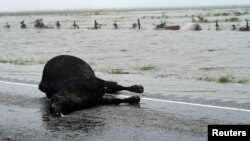South Texas ranchers are scrambling to relocate cattle from massive flooding spawned by Tropical Storm Harvey, with many hauling livestock up to the north of the state while others rush to move the animals to higher ground nearby.
About 1.2 million cattle are located in a 54-county disaster area drenched by Harvey, which made landfall as a hurricane last weekend. With more torrential rain in the forecast, ranchers are expressing worry that some animals could perish despite efforts to save them.
State is top producer of cattle, cotton
Texas leads U.S. states in cattle and cotton production. An estimated $150 million worth of cotton has been lost as the storms ripped the bolls off plants and left white fiber strewn across fields.
Texas Gulf Coast export terminals that handle about a quarter of U.S. wheat exports also remained shuttered.
Of immediate concern to ranchers were cattle stranded by high water infested with venomous snakes, fire ants and alligators, said Hollis “Peanut” Gilfillian, a cattle rancher in Winnie, Texas, about 60 miles (96 km) east of hard-hit Houston.
“We're in gator country ... period," said Gilfillian, adding that nearly every pond on the ranches in his area contain alligators.
“It's not unusual to see an alligator in my backyard or road ditch,” he said, but added, “There's plenty other animals that they (alligators) would much rather eat, such as fish, as opposed to trying to go after cattle.”
Ranchers had tried to prepare for the storm last week by moving cattle to the nearest hills or trucking them to safety in the north of the state, cattle industry groups said.
Chuck Kiker, who raises cattle on his farm near Beaumont, about 60 miles (96 km) northeast of Houston, opted to leave his animals in place but was caught off guard by the storm's severity.
“You can't move animals at this point, so you're kind of stuck because of high water everywhere. There's really no place to move them,” he said.
Disaster area declared
Texas Governor Greg Abbott has declared 54 counties a disaster area. About 27 percent of the state's 4.46 million-head beef cow herd is in those 54 counties, according to Texas A&M University livestock economist David Anderson.
“Given that it's August, I'm not sure that we would've seen a lot of the calves already sold. So you've a lot of young calves out there too that are in that disaster area,” Anderson said.
Grain terminals closed
Longer-term concerns for the cattle include foot rot from standing in water or muddy fields for long periods and the risk of disease from mosquitoes.
Heavy rains and flooding closed bulk grain terminals along the Texas Gulf Coast owned by major exporters including Archer Daniels Midland and Cargill, although the companies say the facilities were not severely damaged.
BNSF Railway and Union Pacific suspended service to the flood-ravaged region, depriving exporters of a fresh supply of grain. The U.S. Coast Guard closed Texas Gulf ports including Houston, Galveston and Corpus Christi.
“With additional flooding likely during the next few days, normal train flows in the area may not resume for an extended period,” BNSF said in a customer service advisory.
Cotton blown away
On cotton farms, more than 300,000 bales have likely been lost, between cotton yet to be harvested and bales sitting on fields awaiting ginning, according to John Robinson, an agricultural economist at Texas A&M University.
The loss, though a small part of the total U.S. cotton crop of about 20 million bales a year, was devastating for individual farmers.
“The cotton that was where the hurricane hit was affected by the winds, it was blown right off the plant. Some of those fields are obliterated,” Robinson said.
“Some of the cotton will still be on the plant but strung out like someone papered your field with toilet paper,” he said.
Record crop lost
South Texas and Coastal Bend cotton farmers were expecting a record crop this year. Thirteen of the counties in the disaster area are major cotton producers.
“The South Texas Cotton and Grain Association has preliminary crop losses projected at $150 million. That's just devastating to all of farmers down there,” Texas Agriculture Commissioner Sid Miller said in a statement.
Monday's Intercontinental Commodity Exchange benchmark cotton price spiked 2.5 percent as a portion of the unharvested crop in Texas was destroyed or damaged by rain and high winds, traders said.
“The cooperative's growers still have a lot of cotton in the field, maybe like 50 percent still out there. A lot of that will be lost because of the wind and rain,” said Jimmy Roppolo, general manager of United Agricultural Cooperative Inc in El Campo, Texas.
“It was the best cotton crop we ever raised. We really needed it this year to make up for other years,” Roppolo said.









